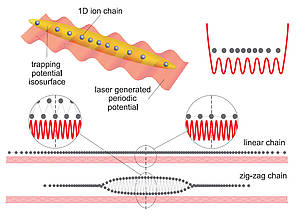Sliding friction and cold ion traps: bridging two worlds

In nanofriction, an established theoretical paradigm is the famous Aubry transition implying a jump from static friction (in the so-called pinned state) to frictionless sliding (so-called superlubricity) as the mutual interaction between two sliding incommensurate hard lattices is reduced. This transition, whose concept is essential in the friction between real crystals is mathematically well defined in one-dimension (1D) only. Alas, there are not so many 1D frictional systems available; and therefore, 30 years after Aubry’s theoretical proof there is as yet no realization of the sudden onset or demise of static friction of 1D incommensurate sliders; and no understanding of the nature of the dynamic friction once a nominally free motion is achieved.
In the totally different context of ultralow temperature atomic gases -- a flourishing field that took off in the 1990s -- experimentalists have demonstrated the ability to trap, besides cold atoms, cold positive atomic ions. Owing to the Coulomb repulsion, the trapped ions form very stable characteristic nano-solid structures, whose nature and shape depends on the trapping potential shape. Once the trapping potential is given the shape of a very elongated cigar, trapped cold ions can form linear chains.
The paper by Benassi, Vanossi and Tosatti shows, based on realistic simulations, that much could be learnt about friction by sliding (e.g. by an external electric field) the trapped ion chains over a laser-generated corrugated potential. To be sure, ion chains are actually always pinned by the trapping potential itself. But the study reveals that a symmetric-asymmetric transition occurs in the trapped chain as the corrugated potential is cranked up. At that transition, an ingeniously defined static friction still can be calculated, and is predicted to rise up from zero in the expected Aubry-like fashion. Besides static friction, dynamic friction is also accessible and its dependence on corrugation shows up directly in ringdown oscillations of the ion trap.
Long theorized static and dynamic one dimensional friction phenomena will thus become accessible in future cold ion tribology, and that with a potential level of control and clarity unachieved so far.
Ballistic Nanofriction

Very few people in the nanofriction community have worried so far about what happens when the sliding is really high speed, a “ballistic” regime which nonetheless appears of great potential interest. Thorough a molecular dynamics simulation study, researchers from AFRI and ACOF CRPs have begun to unravel the elemental mechanisms at play in the frictional dynamics of fast sliding nano-objects deposited on crystalline surfaces. The results appear of relevance to the fundamental understanding of ballistic nanofriction as well as to potential applications in nanosystems such as, e.g., nanoelectromechanical systems and nanomotors increasingly involving large speeds of the moving interfaces. The new findings have been described by R. Guerra, U. Tartaglino, A. Vanossi, and E. Tosatti in Nature Materials 9, 634 (2010); they are highlighted by A. Schirmeisen’s paper “Nanofriction: Surfing on graphite waves” in news & views (Nature Materials 9, 615 (2010)).
Breakthrough in atomic resolution studies of deposited nano-objects

EuroFANAS project NOMCIS has achieved a breakthrough in overcoming one of the main limitations in atomic resolution studies of deposited nano-objects on insulating surfaces – the identification of ions in the imaged surface. This is an important step in characterization and technology realization, since since such surfaces are critical as model substrates in molecular electronics and nanocatalysis.
Suppression of Friction by Mechanical Vibrations
Thorough molecular dynamics simulations, researchers from AFRI and ACOF CRPs have proposed a theoretical explanation of the suppression of friction in a confined system under shear subjected to small mechanical vibrations. The important result could help in improving frictional properties of nano-devices and, as well, in explaining earthquake triggering by small dynamic perturbations.
Dynamical Chiral Symmetry Breaking in Sliding Nanotubes
Simulations in the group of E. Tosatti of AFRI and ACOF CRPs discovered an unanticipated nanoscale example of dynamical symmetry breaking in the sliding of perfectly left-right symmetric and nonchiral nanotubes. At a series of critical sliding velocities, corresponding to large frictional peaks, a nonzero angular momentum of phonon origin appears spontaneously.
Controlling microscopic friction through mechanical oscillations (20 November 2008)
Researchers from ACOF Collaborative Research Project investigate the effects of external mechanical solicitations to the tribological properties of sliding interfaces. The results have been published in Physical Review E 78, 036110 (2008). Read more...

